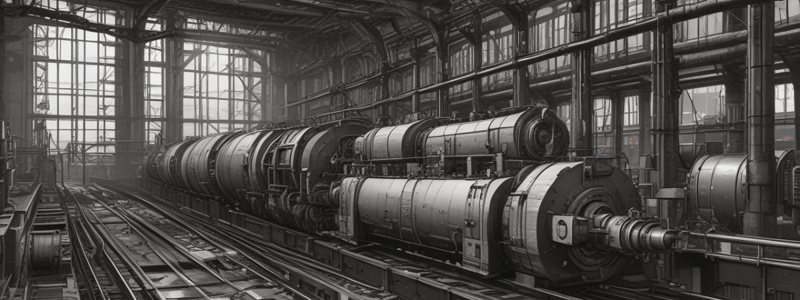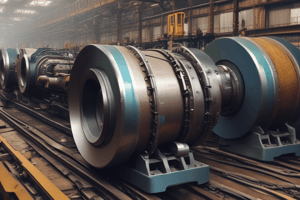Podcast
Questions and Answers
What is the recommended surface hardness achieved through carburizing?
What is the recommended surface hardness achieved through carburizing?
- 40 to 50 HRC
- 30 to 40 HRC
- 60 to 70 HRC
- 50 to 60 HRC (correct)
Which of the following steels can be used with nitriding?
Which of the following steels can be used with nitriding?
- Low carbon steels
- High carbon steels
- Stainless steels
- Chromium-molybdenum alloy steels (correct)
What is the primary objective of the recovery stage in annealing?
What is the primary objective of the recovery stage in annealing?
- Relief of Internal Stresses
- Formation of New Grains
- Reduction of Dislocation Density (correct)
- Relief of External Stresses
What happens when the heat-treating atmosphere is not controlled?
What happens when the heat-treating atmosphere is not controlled?
What is the driving force for recrystallization?
What is the driving force for recrystallization?
What is the recommended method for heavy cases or selective hardening of large machine components?
What is the recommended method for heavy cases or selective hardening of large machine components?
What is the primary purpose of surface hardening?
What is the primary purpose of surface hardening?
Which of the following components is usually not surface-hardened?
Which of the following components is usually not surface-hardened?
What is the minimum carbon content required for carburizing?
What is the minimum carbon content required for carburizing?
What is the maximum surface hardness achieved through carburizing?
What is the maximum surface hardness achieved through carburizing?
What is the temperature range for carburizing?
What is the temperature range for carburizing?
What is the maximum carburizing time?
What is the maximum carburizing time?
What is the primary function of the stress relief process?
What is the primary function of the stress relief process?
What happens to the grain boundary area during grain growth?
What happens to the grain boundary area during grain growth?
What is the driving force behind grain growth?
What is the driving force behind grain growth?
What is the significance of temperature control in annealing?
What is the significance of temperature control in annealing?
What is a key advantage of powder metallurgy?
What is a key advantage of powder metallurgy?
What is a characteristic of the powder metallurgy process?
What is a characteristic of the powder metallurgy process?
What is the process of diffusing nitrogen into the surface of steel?
What is the process of diffusing nitrogen into the surface of steel?
What is the temperature range for nitrocarburizing?
What is the temperature range for nitrocarburizing?
What is the purpose of selective hardening?
What is the purpose of selective hardening?
What is the typical hardness achieved by flame hardening?
What is the typical hardness achieved by flame hardening?
What is the process of heating the steel part in induction hardening?
What is the process of heating the steel part in induction hardening?
What is the minimum carbon content required for flame hardening?
What is the minimum carbon content required for flame hardening?
What is the primary factor that determines the shape of particles?
What is the primary factor that determines the shape of particles?
What is apparent density defined as?
What is apparent density defined as?
What is the purpose of adding lubricants during mixing and blending?
What is the purpose of adding lubricants during mixing and blending?
What is the purpose of compacting mixed powders in a die?
What is the purpose of compacting mixed powders in a die?
What happens to the green compact when it is removed from the die?
What happens to the green compact when it is removed from the die?
What is the purpose of pre-sintering?
What is the purpose of pre-sintering?
What is the purpose of sintering?
What is the purpose of sintering?
What type of furnace is used for sintering?
What type of furnace is used for sintering?
What is the purpose of secondary operations?
What is the purpose of secondary operations?
What is compressibility defined as?
What is compressibility defined as?
What is the benefit of powder metallurgy in terms of production rates?
What is the benefit of powder metallurgy in terms of production rates?
What is a limitation of powder metallurgy in terms of product design?
What is a limitation of powder metallurgy in terms of product design?
What type of parts are typically produced using powder metallurgy?
What type of parts are typically produced using powder metallurgy?
What is a common application of powder metallurgy?
What is a common application of powder metallurgy?
What is a method used to produce metal powders?
What is a method used to produce metal powders?
What determines the behavior of metal powders?
What determines the behavior of metal powders?
Flashcards are hidden until you start studying
Study Notes
Surface Hardening of Steels
- Purpose of surface hardening:
- Improve wear resistance
- Improve resistance to high contact stresses
- Improve fracture toughness
- Improve fatigue resistance
- Improve corrosion resistance
- Components usually surface-hardened:
- Gears
- Bearings
- Valves
- Shafts
- Bearing races
- Cams
- Hand tools
- Rolls
- Machine tools
- Sprockets
Heat-Treating Methods
- Diffusional methods:
- Carburizing
- Nitriding
- Carbonitriding
- Nitrocarburizing
- Boronizing
- Chromizing
- Selective hardening methods:
- Flame hardening
- Induction hardening
- Laser and electron beam hardening
Carburizing
- Process: adding carbon to steel surface
- Types of carburizing:
- Pack carburizing
- Vacuum carburizing
- Gas carburizing
- Plasma carburizing
- Carbon content achieved: 0.7 to 1.2 wt.%
- Suitable for: Low-carbon steels and alloy steels containing 0.08 to 0.2 wt.%C
- Carburizing temperature: 850-950 °C
- Carburizing time: 4 to 72 h
- Mechanism:
- Surface hardness achieved: 55-65 HRC
- Case depth: No technical limit; in practice, 0.5 to 1.5 mm
- Applications:
- Gears
- Cams
- Shafts
- Bearings
- Piston rings
- Clutch plates
- Sprockets
Nitriding
- Process: diffusing nitrogen into steel surface
- Suitable for: Low-carbon alloy steels containing Al, Cr, Mo, V, Ni
- Nitriding time: Less than carburizing time
- Applications:
- Gears
- Valves
- Cutters
- Sprockets
- Pump-boring tools
- Fuel-injection pump parts
Carbonitriding
- Process: adding both carbon and nitrogen simultaneously
- Suitable for: Mainly for low-carbon steels; medium-carbon steels sometimes
- Temperature: 700-800 °C
- Carbonitriding time: Less than carburizing time
- Applications:
- Gears
- Bolts
- Nuts
Nitrocarburizing
- Process: thermochemical low-temperature process
- Temperature: 482-593 °C
- Applications:
- Wear/friction resistance
- Similar to carburizing, but with lower distortion
Selective Hardening Methods
- Flame hardening:
- Process: heating with combustible gas flame
- Suitable for: At least medium-carbon steels containing ≥ 0.40 wt.%C, cast irons
- Surface hardness achieved: 50-60 HRC
- Case depth: 0.7-6 mm
- Applications:
- Lathe beds and centers
- Crankshafts
- Piston rods
- Gear and sprocket teeth
- Axles
- Cams
- Shear blades
- Induction hardening:
- Process: heating with high-frequency alternating current
- Suitable for: Medium carbon steels (wt.% C = 0.4), cast irons
- Surface hardness achieved: 50-60 HRC
- Case depth: 0.7-6 mm
- Applications:
- Similar to flame hardening
Recovery, Recrystallization, and Grain Growth
- Recovery:
- First stage of annealing process
- Reduces dislocation density
- Relieves internal stresses
- Partially restores properties
- Recrystallization:
- Forms new, strain-free grains
- Relieves internal stresses
- Completes stress relief
- Critical temperature and time depend on prior deformation, material composition, and purity
- Grain growth:
- Reduces grain boundary area
- Reduces system energy
- Depends on temperature, time, and impurities
- Normal vs. abnormal grain growth
Powder Metallurgy
- Advantages:
- Produces parts with closed dimensional tolerance and good surface finish
- Eliminates or minimizes scrap losses
- Can be fully automated
- Facilitates manufacture of complex shapes and unique compositions
- High production rates
- Limitations:
- High cost of powder material
- Difficult to produce parts with intricate design
- Residual porosity in sintered parts
- Economically feasible for large volume production
- Difficult to compress some metal powders
- Health problems from atmospheric contamination
- Applications:
- Production of porous parts (e.g., filters)
- Tungsten and Molybdenum components
- Automotive components (e.g., clutch plates, connecting rods, cam shafts, piston rings)
- Grinding wheels
- Nozzles for rockets and missiles
- Complex-shaped parts
- Electrical bushes for motors
- Permanent magnets
- Production of metal powder:
- Atomization
- Crushing and milling
- Electrolysis process
- Chemical process
- Characteristics of metal powders:
- Particle shape and size distribution
- Density (true and apparent)
- Flow rate
- Compressibility and compression ratio
- Processing of powders:
- Mixing and blending
- Compacting
- Sintering### Powder Compaction
- Green compact expands slightly due to elastic recovery when removed from the die.
- The expansion depends on the pressure and extent of plastic deformation in powder particles.
Pre-Sintering
- A process where green compact is heated to a temperature below the final sintering temperature to increase strength.
- Removes lubricants and binders added during blending.
- Performed only when machining is not required.
Sintering
- Heating material to a temperature below the melting point, allowing bonding or fusion of individual particles.
- Performed under a protective atmosphere to prevent oxidation.
- Continuous sintering furnace used, consisting of:
- Burn-off chamber: volatizes lubricants to improve bond strength and prevent cracking.
- High-temperature chamber: for bonding between powder particles.
- Cooling chamber: for cooling the sintered part.
Secondary Operations
- Performed to obtain desired dimensional tolerances and physical properties.
- Operations include:
- Finishing operations for better dimensional accuracy.
- Machining operations for specific shapes and sizes.
- Heat treating to improve hardness, strength, and wear resistance.
- Finishing operations to improve surface characteristics of the part.
Studying That Suits You
Use AI to generate personalized quizzes and flashcards to suit your learning preferences.





